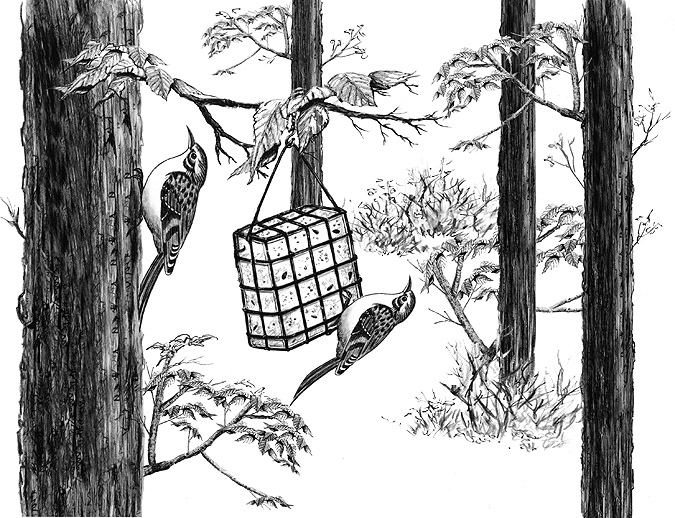
Dear Bird Folks,
This week I’ve seen several Brown Creepers on my morning walks. Why so many and why now? Have I just been lucky or are these birds passing through on their way south?
– Amy, Eastham, MA
Not another Amy, Amy,
Last week’s question was from Amy in Somerville, MA (remember her, with the sparrows?). Now you say your name is Amy, too? If I’ve done the math right, this makes two Amys in a row. I usually don’t answer questions from people with the same name in consecutive weeks, but I’m going to make an exception this time. Why? Because Brown Creepers are one of my favorite birds and I don’t want to miss a chance to write about them, even if it means dealing with another Amy, Amy.
I like everything about Brown Creepers. I like the way they fly, they way they look and the way they sing. And most of all, I like their name, “Brown Creeper.” It sounds like a character in a Stephen King children’s story. Imagine sitting around a campfire, telling scary stories and saying, “… and then suddenly the Brown Creeper appeared out of the darkness.” Whoa! See what I mean? Scary. (Hang on a second while I check to make sure I’ve locked the backdoor. Okay, it’s locked.)
The irony here is that Brown Creepers aren’t creepy at all. They are one of the sweetest little birds you’ll ever see. They are smaller than a titmouse, weigh less than a chickadee and never bother anybody. They don’t even spread gossip, unless it’s really juicy gossip. These birds live their lives out in the open, yet they aren’t often seen. Brown Creepers are able to remain hidden in plain sight because of their coloring, which, as you can imagine, is brown. They are dull birds, going through life with all the excitement of a bran muffin, and they like it that way. The last thing they want to do is draw attention to themselves. The “creeper” part of this bird’s name refers to its habit of creeping up the trunks of trees. Brown Creepers start their day on a tree trunk and end it the same way. It’s the same routine every day. I bet we all know people like this. People who always wear the same outfits, eat the same foods and watch the same TV shows. These folks would make good Brown Creepers, except creepers rarely watch TV. They can’t stand all those ads from that annoying furniture guy.
Brown Creepers behave much like our other trunk-clinging birds, the nuthatches. However, nuthatches typically forage by walking down a tree headfirst. Creepers would never do that. Walking upside down is way too adventurous for these timid birds. Instead, they walk up the tree, clinging securely to the trunk with their long, Howard Hughes-like claws. As they ascend the tree, they scan constantly for any insects hiding under the bark. When they get bored with one tree, they fly to the base of the next one and start over. However, they don’t fly in the typical manner. They fly down with a bizarre fluttering motion, looking like a dried leaf wrestling with a moth. (Don’t ask me why a moth would wrestle a dried leaf, that’s just the best analogy I can think of right now.)
Tree trunks are so important to creepers they even raise their families on them. Unlike other songbirds, which build their nests in a tree’s upper branches under the fresh spring foliage, creepers build their nests right on the sides of trees. You would think a nest built in such a conspicuous spot would be easy to find, but think again. These crafty birds squeeze their nests behind pieces of peeling bark. Their nests, which consist of small twigs and soft grasses, are held in place with spider webs, insect cocoons and sometimes Super Glue (when they can find it on sale). Every time I go for a walk in the woods I’m constantly on the lookout for a creeper’s nest and after all these years I have yet to find one. Of course I can’t find my car keys half the time either, but that’s another story.
Creepers are quiet most of the year but the breeding season is the exception. While the female is sits on her eggs, the male announces his territory. But again, unlike most other songbirds, he doesn’t sit at the top of a tree and belt out booming songs. He emits soft, high-pitched notes. And from what location does he sing these notes? That’s right, from the trunk of a tree. As the male forages, the notes seem to slip out of him, like a package delivery guy who whistles a few random notes for no apparent reason.
After the breeding season creepers may migrate, or they may not. This part of their natural history is poorly understood. It seems some of the northern birds push south while most of the birds in more moderate climates stay put. Here on the Cape we have a good population of creepers year-round. But, as you have noticed, Amy, we seem to have even more in the fall. This suggests creepers from the north like to visit the Cape on their way south.
Finally, even though creepers aren’t considered to be “feeder birds,” many folks report seeing these shy birds occasionally taking bits of suet when they think no one is looking. So keep your eyes open. The next time you see a dull, bran muffin-like bird on your suet feeder, it could be a Brown Creeper. Just don’t eat it. Creepers don’t taste very good, but they don’t taste nearly as bad as a bran muffin.